mytest
Books, eBooks, and more from Dr. ARUDOU, Debito (click on icon):
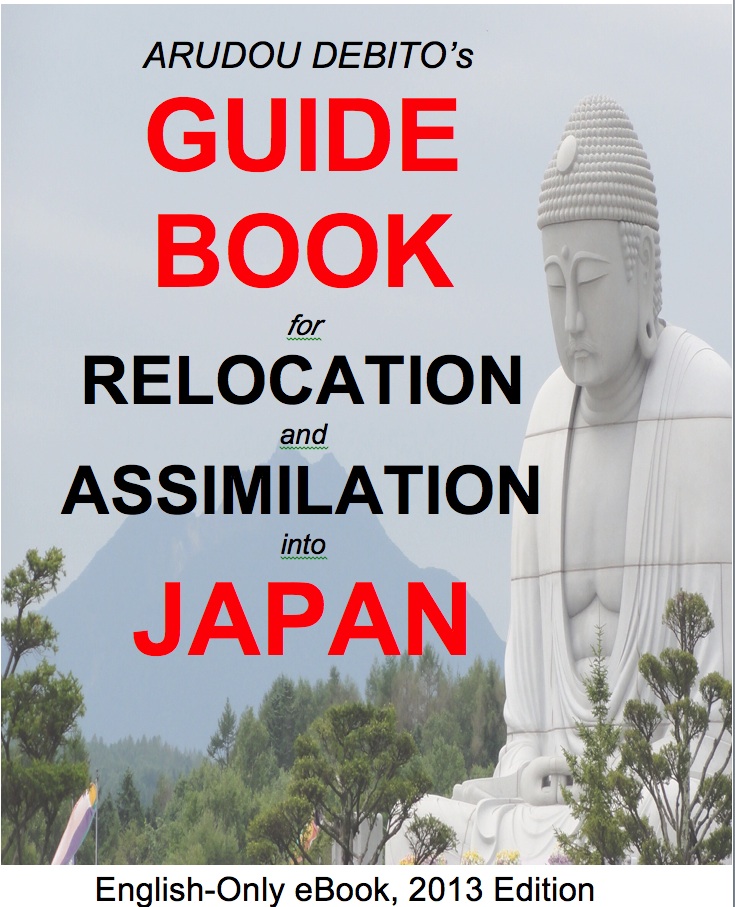
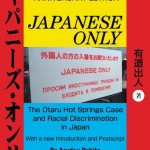
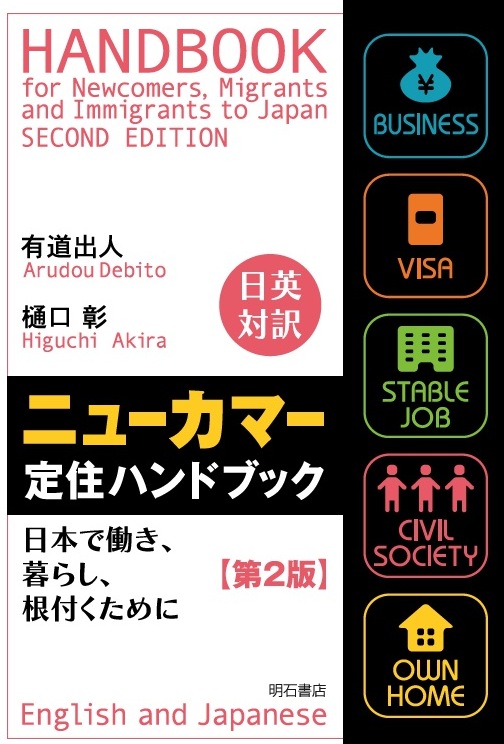


![]()


UPDATES ON TWITTER: arudoudebito
DEBITO.ORG PODCASTS on iTunes, subscribe free
“LIKE” US on Facebook at http://www.facebook.com/debitoorg
https://www.facebook.com/embeddedrcsmJapan
http://www.facebook.com/handbookimmigrants
https://www.facebook.com/JapaneseOnlyTheBook
https://www.facebook.com/BookInAppropriate
If you like what you read and discuss on Debito.org, please consider helping us stop hackers and defray maintenance costs with a little donation via my webhoster:

All donations go towards website costs only. Thanks for your support!
Hi Blog. Despite all the campaigns to increase foreign tourism and “prepare” Japanese society for the Tokyo 2020 Olympics, sometimes Debito.org feels like suggesting people just avoid Japan’s sweaty-headed public-servant busybodies, who spend our tax monies to further alienate NJ residents and tourists from the rest of Japanese society. Check these out:
///////////////////////////////////
March 17, 2016
From: “Concerned Long-Time NJ Resident”
Dear Dr. Arudou,
Here is the full “Shinjuku Foreign Residents” guide available online.
In English: http://www.seisyounen-chian.metro.tokyo.jp/about/pdf/poster-leafret/frm-english.pdf
In case it disappears: ShinjukuForeignResidentManual2016
In Japanese (which was not available at the kuyakusho office, only foreign language versions were there): http://www.seisyounen-chian.metro.tokyo.jp/about/pdf/poster-leafret/frm-japanese.pdf
In case it disappears:ShinjukuForeignResidentManualJ2016
Some screen captures follow. Here is the cover and back cover:
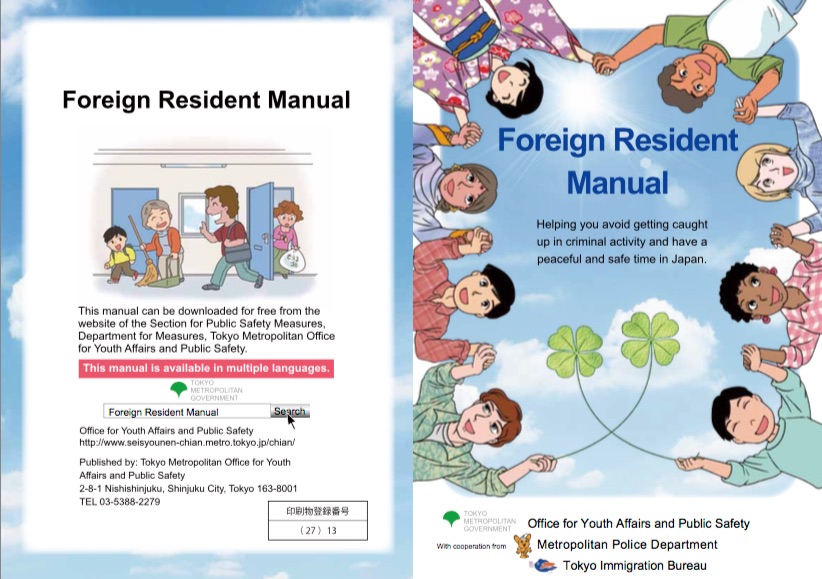
COMMENT FROM DEBITO: Note how this is a guide designed to “avoid getting caught up in criminal activity” (yes, hanzai in the original Japanese). Yet look at the first four pages within. Find the crimes:
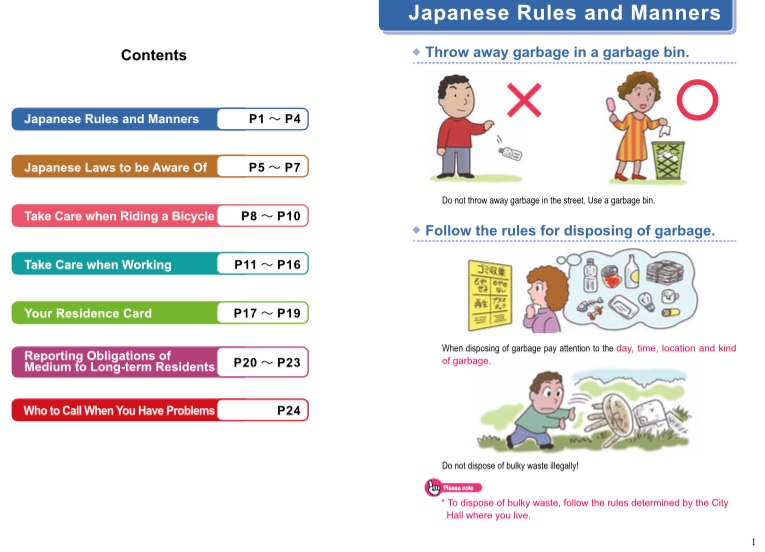
Right. That age-old canard about foreign residents being mentally incapable of throwing away their garbage correctly. I can think of plenty of Japanese I’ve seen having the same trouble, only without being accused of “criminal” activity. And it’s not a crime anyway. Nor are these activities:
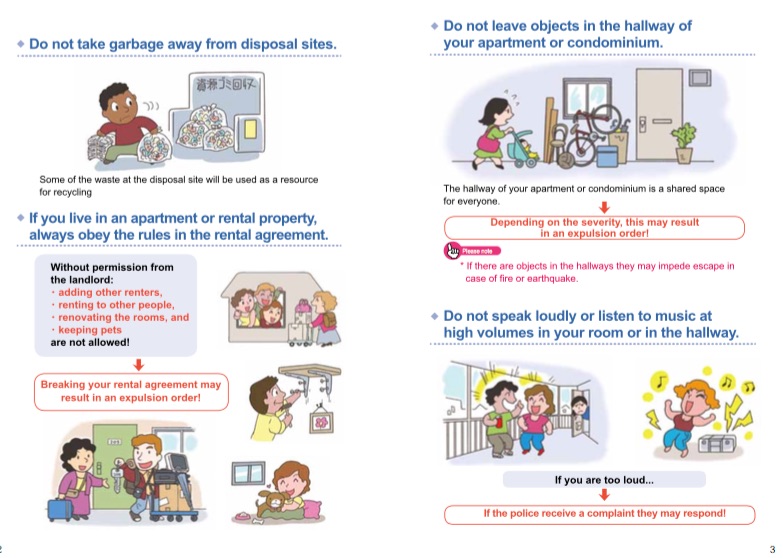
COMMENT FROM DEBITO: I’m quite sure the police will respond. But not because they received a complaint about the Japanese in my neighborhood I’ve experienced that hoard, are untidy, or are noisy at inopportune times. Rather, police will respond because they got tipped off by some busybody claiming a foreigner was “suspicious” (grounds for arrest in Japan if you’re suspicious while foreign-looking), which is something this manual can’t caution against.
And how about this one:
COMMENT FROM DEBITO: Crikey. This manual should be distributed to Japanese! Flagrant rule-breakers on a regular basis there! But Japanese, not foreigners, aren’t assumed to be criminal, because Japan, runs the narrative, is a peaceful, safe, law-abiding society, whereas foreign countries, and their foreigners, by definition, are not, because we Japanese are different and unique and… oh, you get the idea.
Anyway, here’s what submitter “Concerned Long-Time NJ Resident” had to say about this manual:
======================================
This guide still has me angry that this sort of view of “foreigners” is still persisting—maybe even growing—as the Olympics approach; worse, it is being promoted by a government agency. I have been stopped by the Japanese police many times (for no reason other than being “foreign-looking”) and treated like a criminal when I simply pass through the train station, and I’ve seen similar treatment at the station of other “foreigners.” So after those experiences, pamphlets like this that further the view of non-Japanese in Japan as criminal-prone imbeciles really rub me the wrong way. There are plenty of guides for residents of Japan that do NOT take this approach with non-Japanese residents when explaining laws and helpful services that have been translated to other languages.
I have already called and complained to the organization that put this guide out and the kuyakusho office as well. Thank you for giving a voice against such issues when so few in Japan even speak up for the rights of non-Japanese residents (and Japanese too) in Japan. It is greatly appreciated. As for credit, just leave out my name and say it was from “a concerned long-time non-Japanese resident” of Japan. I’m most concerned about the issue rather than any credit, plus I don’t need to be harassed by any rightwing nuts.
======================================
Meanwhile, it’s not just Shinjuku. The Yomiuri reports on NJ-targeting busybodies elsewhere:
======================================
From: JK
Date: May 12, 2016
Hi Debito: This was a new one for me:
Picture signboards to cultivate manners of foreign tourists
The Yomiuri Shimbun, May 11, 2016
http://the-japan-news.com/news/article/0002901542
A signboard set up until early April on a path along the Chidorigafuchi moat in Chiyoda Ward, Tokyo
With breaches of etiquette by foreign tourists becoming a problem in tourist spots nationwide, local communities are using signboards featuring illustrations, pictograms and manga to inform visitors of how best to behave.
These moves are aimed at helping foreign tourists understand Japanese etiquette and rules, in order to prevent such trouble, but some are concerned that the signs could spoil the scenery at tourist spots.
In three locations that are good for viewing cherry blossoms in Chiyoda Ward, Tokyo, including the Chidorigafuchi moat, signboards were set up this spring for the first time, urging visitors not to break cherry tree branches. Explanations were written in English, Chinese and Korean with a pictogram of a hand trying to hold a tree branch and a line through it.
According to the Chiyoda City Tourism Association, which set up the signboards, it had received complaints from a large number of nearby local residents and Japanese tourists that foreign tourists were breaking the branches of cherry trees. To inform them in an easy-to-understand way that this is a breach of local mores, the association decided to include the illustration on the warning signboards.
Some signboards explain etiquette using manga. Fushimi Ward, Kyoto, set them up in February in a parking area for large buses near the Fushimi Inari Taisha shrine.
Sets of four-frame cartoons warn visitors not to enter the premises to take memorial photos and explain how to use Japanese-style toilets. About 2,000 tourists arrive daily at the parking area. Many of them are with group tours from Asian countries, Europe and the United States.
An official of the ward office expects the signboards to be effective, saying, “We hope visitors will understand the proper etiquette while they’re in the parking area and then go on to enjoy their visit.”
In 2015, the number of foreign tourists to Japan hit a record high of 19.73 million.
The Cabinet Office conducted a survey of 3,000 Japanese nationals nationwide in August last year about the situation involving foreign tourists.
With multiple answers allowed regarding things people are worried about as the number of foreign tourists increases, 26 percent of respondents cited growing trouble due to differences in etiquette, cultures and customs. This figure was the second highest after the 30 percent who mentioned security issues.
Match signs to surroundings
Signboards were set up to avoid such trouble, but the signs themselves have also caused concern.
Kyoto’s Gion district is lined by many ochaya tea houses and ryotei Japanese restaurants, and Gionmachi Minamigawa Chiku Kyogikai, an association of local residents in the southern part of the Gion district, set up wooden signboards about two meters tall at four locations there in December last year.
Pictograms and X marks are used instead of letters. They warn against six kinds of prohibited actions, including pulling on the kimono sleeves of maiko and leaning against or sitting on fences.
However, the district is designated by the Kyoto city government as a zone for the maintenance and improvement of historical scenic beauty.
A senior member of the local association said, “We didn’t want to set up the signboards because they impair the scenic beauty, but we could not overlook the breaches of etiquette.”
Seiko Ikeda, a specially assigned professor at St. Agnes’ University, who is studying relations between scenic beauty and signboards in tourist spots, said, “Although I understand the feelings of local residents, I feel uncomfortable about such signboards.”
She added: “Also, in the context of hospitality for foreign tourists, more comprehensive consideration is necessary. For example, such signboards should not bear pictures or designs with aggressive images, and they should harmonize with the surrounding scenery.”
Nobuko Akashi, president of the Japan Manner and Protocol Association, a nonprofit organization that recommends other measures than signboards, said, “Steady efforts are essential, such as thoroughly notifying visitors about etiquette and rules before they come to Japan via information websites for overseas.”
ENDS
============================================
SUBMITTER JK COMMENTS: All these foreigners keep causing meiwaku because they don’t have proper manners or etiquette, so while we didn’t want to spoil the view, we couldn’t gaman anymore and put up signboards telling them what not to do. Perhaps if we nix the pictures and blend the signboards into the surrounding scenery, the view wouldn’t be so spoilt.
My problem with “helping foreign tourists understand Japanese etiquette and rules” is two-fold.
First, it knows no bounds (e.g. Don’t break the branches, and while you’re at it, don’t pull on the kimono sleeves of maiko or lean against or sit on fences).
Second, it’s decidedly one-sided mindset (e.g. Do the local residents understand why the cherry tree branches are being broken? Is it unintentional or unintentional? Do foreign tourists dislike cherry tree branches?). Regards, JK
============================================
CONCLUDING WORD FROM DEBITO: I understand full well the need for cautioning people when tourists, or anyone, are disrespectful towards local sights and environments. But creating reactionary media that stigmatizes foreigners as if they are natural-born criminals or incorrigible rule-breakers (i.e., naturally unable to follow rules because they are foreigners) is equally disrespectful. Care must be taken and tact used to avoid belittling guests, not to mention alienating NJ residents, and busybodies who get paranoid about any strangers darkening their doorsteps must not have free rein to overthink countermeasures (for it soon becomes an invitation to xenophobia).
How about the government or these self-appointed local “manner and protocol associations” quietly advising tour agencies to rein in their patrons, and make the rules clear, as Japanese tour agencies do for Japanese abroad? It worked in the Otaru Onsens Case. Dr. ARUDOU, Debito
Do you like what you read on Debito.org? Want to help keep the archive active and support Debito.org’s activities? We are celebrating Debito.org’s 20th Anniversary in 2016, so please consider donating a little something. More details here.
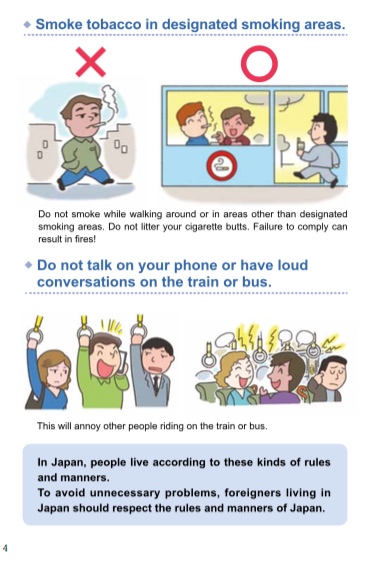
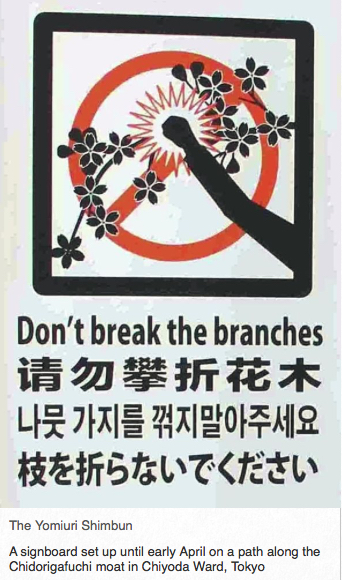
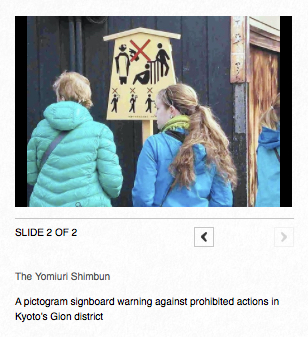
24 comments on “GOJ busybodies hard at work alienating: Shinjuku Foreign Residents Manual assumes NJ criminal tendencies; Kyoto public notices “cultivate foreign tourist manners””
Wonderful write up and compilation. Thanks for giving this issue attention.
The small odakyu Line station near my work is ON terror alert ! man size banners are in the small station area…..WTH ?
Gotta love the one about “smoking only in designated areas”. Someone should tell the Japanese this.
Just an excuse to push naive (or not so) NJs around. I was making a phone call from a public phone on the platform of a JR station and this Oyaji actually INTERRUPTS MY CALL to tell me to “not lean on the phone stand”.
Hang on a sec. Which is ruder? And I am paying for this call.I had to stand close to the stand to be able to hear, so I was much irked by this busybody. And as he wasnt much older than me, so began the Confrontation of Oyajis.
The station staff was passing, so I thought I would just nip it in the bud by saying to him, “please call the police, this guy is bothering me”. I was just following Japanese modus operandi here, and Oyaji immediately backed off with “This isnt a matter for the police”, and he jumped on a train as it pulled away, glaring at me. I returned the glare.
Ditto a similar rule in (the deserted at the time) Meiji jingu, “Dont sit on the ground” (actually only our Japanese friends were doing so).
I think it is the duty of these busy bodies to help people, not just scold them or boss them around, so I followed him, asking in Japanese about the facilities We CAN use (I hate to end a conversation on a negative note, and wanted a positive outcome).
He was absolutely unhelpful- he couldnt tell us where we could sit, or even where the toilets were. He wanted to get away, but I kept asking him questions, like “Please tell us who can assist us, we are tourists”.
Nope, these “staff” just want to play the elder Sempai to the NJs.
S@d that, what about Omotenashi? They need retraining in “positive solutions in Customer Service”.
Oh it even has that “show your gaijin card to the police when they ask for it”
What if that falls into shokumu shitsumon? This reeks.
@ Pwnzudauce #5
A guide book for tourists talking about showing your ‘gaijin card’?
I think that tells us all we need to know; this isn’t really a bodged attempt to make a guidebook aimed at NJ tourists, this is really a rule book for interfering would be busybodies to know if it’s ok to call the police when they see a gaijin; ‘these behaviors are ok, but gaijin shouldn’t be doing this’ kind of thing.
I finally got my book embedded racism today!
— Enjoy!
I suspect that quite often in Japan these warnings that are put in public view ostensibly to “teach” foreigners proper Japanese manners/etiquette are actually designed more for rule breaking Japanese people as a means of coyly shaming them into toeing the line.
Causing meiwaku by smoking in public, for instance, is something done much more often by Japanese people, but looking at the warning you would think the uncouth behavior is largely done by trouble-making foreigners.
The message the petty tyrant powers that be are sending is that if a Japanese person does something unsavory, that person is somehow more like a foreigner than a true/pure Japanese person, heaven forbid. The technique is used ubiquitously in Japan by civil servants, teachers, parents, bosses and works like a charm for getting people to obey and coalesce, but the very unsavory consequence is that it breeds a bigoted view of the non-Japanese community.
— That’s really quite insightful.
@Bill,
Ive noticed that as well at other locations/experiences in Japan. Its easier to target the scapegoat foreigner rather than address the issue directly. The fear of group rejection is overwhelming for many Japanese, and this cultural taboo topic is easier dealt with through foreigners. “you did” or “its you” the gaijin becomes a source of attraction for all the unspeakable taboos. Sometimes it feels like the foreigner experience is a human rights violation made legit. Everything in Japan revolves around the concept of us vs. them. You call a place asking if foreigners work there, only to get a lie that none do, find out that many are there. You talk of going abroad, then your met with looks of fear and disbelief. The lock down mentality is very powerful in Japan
@Bill:
It sounds like what you are proposing is a variation of slut-shaming (gaijin-shaming?).
Have a look here:
Slut-shaming has little to do with sex, study finds
http://america.aljazeera.com/articles/2014/5/29/slut-shaming-study.html
I think you’ll find the parallels are striking (e.g. in both cases, the underlying mechanism at work is bullying).
Gaijin-shaming, it seems, has little to do with foreigners.
Regards,
-JK
Damn Bill, I never thought about it like that way… Interesting.
@Bill
“The message…is that if a Japanese person does something unsavory, that person is somehow more like a foreigner than a true/pure Japanese person, heaven forbid.”
I think this same type of thing–i.e., notions about an assumed Japanese identity and the need to cultivate and protect it–also explains the lack of political will to widely embrace English fluency in Japan. It may not be considered unsavory, but speaking English well is, with a few exceptions, relentlessly characterized as not a Japanese thing–it is something foreigners do. And to act like a foreigner is to invite scrutiny or worse. To embrace English in any meaningful way is also to be exposed to non-Japanese sensibilities. Why would the guardians of Japanese identity, i.e., the powers that be, not be terrified of that?
@ JK #10
“Gaijin-shaming, it seems, has little to do with foreigners”.
Whilst bullying, as we know, has everything to do with Japan.
Just had a flashback about how bad Japanese are called “gaijin”and shamed. a girlfriend’s friend was complaining about her no good Japanese boyfriend and blurted out, ” gaijin yori saiyaku” or words to that effect. “Worse than a gaijin”.
I quizzed her what she meant, and was assured that it did not mean me, but rather the “bad” gaijin or “furyou”. A “Furyou” was defined as a gangster by them.
And yet.
This was when I was younger and doing a homestay at the time, and I recall the family I stayed with also used to say things to me as well like “don’t act/talk/say that, it sounds like a “furyou gaijin”.
THIS DID NOT COMPUTE at the time, as it was contradictory of the other spiel I was simultaneously being fed, that of the Western Gaijin as Honored Guest role. And during my Honeymoon Period, I admit that I lapped it up and loved it, although I was othered, excluded, and kept in the genkan in all meaningful transactions with my homestay family as temporary Gaijin Handler.
Presumably then, a “furyou” was an untamed NJ, and not a guest or new arrival with Handler. Said family was quite conservative and aspiring upper middle class (in their minds but not in reality) whom also disdained lower class Japanese as “Like furyou gaijin”. E.g. expressions like “ano saaa” was to them an expression representative of lower classes. Presumably this is how they built their self identification with a “better” class of people.
After a while, I noticed the scope of what was “furyou” had widened to include things like chewing gum, or asking “why” about certain rules or not letting things be “as they are” or challenging opinions that were “shouganai” as “shoganakunai” (definitely a taboo). Or even not tailoring my English lesson style enough to the Elder Obaasan who ironically did not want a “genki” style. “Fu majime” was one step away from being labelled “Furyou”.
Years later (in the Ishihara Zeitgeist) the direct comparison to a “furyou” was less heard, but instead I was told directly I was breaking certain taboos by, e.g. not taking one for the team (what team?) by working all night for free (not exaggerating), or acting like a “non member of the team” by e.g. going home on the last train. (this particular work case study was interesting tangentially because there was no middle ground, I either had to stay all night or was off the “team” both socially and professionally).
I think this ties in with the decline of the days of any Johnny Westerner in Japan as automatically assumed honored guest (on a level with the red carpet treatment rolled out in the 80s, anyway), and the rise of a certain weariness with tiresome NJ ways (like qny of the above)and/or lack of interest in western tourists, although a superficial confirmation of cliches still exist as casual conversation topics.
“I move that Sakurai’s “white Pig Go home” couldnt have happened in public in the 80s, and though this is hard to prove either way, there is usually a correlation with economic downturns and rising frustrations with broader scapegoating, as if our American Overlords have failed us and are therefore proven to only be standard or garden gaijin after all, not special.And therefore open to abuse. https://www.youtube.com/watch?v=hzmgyFQNvvU
My personal anecdote is that in the 80s Westerners were honored guests, but in the mid 2000s I was instead getting former friends and colleagues comments like “Why do you keep coming here? We do not really need you- Japanese people lost interest in Gaijin (westerners) a long time ago”.
These days it seems that it is safely assumed by many Japanese that NJs are in fact disenfranchised, and therefore irrelevant at best and at the bottom rung at worst. Thus direct verbalizations of comparisons to “Furyou gaijin” are no longer needed to maintain correct behavior, as it goes without saying.
“Hang on a sec. Which is ruder? And I am paying for this call.I had to stand close to the stand to be able to hear, so I was much irked by this busybody. And as he wasnt much older than me, so began the Confrontation of Oyajis”
Thats how allot of things get kicked off in Japan. Be careful. In a situation like that, you handled it well. Like the phone or what you are doing is any of his business. Its not his property, so he had no reason to even scold you; it was only because you were a gaijin. Id like to see him ask a Japanese man not to lean up on the phone, then see what happens.
One thing I noticed was that, although inappropriate employment practices and attempts to swindle foreigners are mentioned (12 – 14), the only illegal activities that readers of the pamphlet are to report are those of foreigners (12).
I must say, this is one of the most interesting conversations I’ve seen on this site in a long time. Had never thought of foreigners’ image being used and percieved this way in Japanese society.
@ Tim, thanks. I was fortunate as a Japanese official in a uniform (the meek MTR staff) was just passing by at the time, although he did not seem to want to get involved.
Wherever possible, try to delegate the problems to a trusted Japanese. I know this smacks of Gaijin Handlers, but why take on negative energy and stress? Non issues created by any Japanese who try to project it onto gaijin should be handed back to the Japanese as much as possible.
After all, by their logic, you are just visiting here anyway…..Why get involved?
“Foreign Resident Manual” says it all. This clearly targets NJ residents.
The “Don’t break the branches” part targets foreign tourists.
While we may be able to tell the difference, it seems that the geniuses at the GOJ propaganda department cannot.
p.14 – is that a reference to airbnb?
keep up the good work all. It looks like we are getting noticed!
Baudrillard: I just had a flashback to my college days here. I had a family I could visit on the weekends if I called them a week or so beforehand (which of course I did). I was very nice to them (as my parents taught me to be) and they were initially nice to me but as time went on, The home-visit sister (who went to my university) said that she was disappointed in me because she wanted the french guy in my class to be her gaijin visitor so I shouldn’t come anymore.
Disappointed but not disheartened, I went for another couple of visits only to be told by friends of mine who met them that the family said that they couldn’t understand my Japanese (I was a beginner then) so they don’t seem very nice people. Plus they complained that I was hairy…..
So the whole point is I played the nice guy until I did something wrong which I wasn’t aware of and it upset me for a long time
@Tim,
Its these micro nuisance experiences that show that Japan has a long ways to go before immigration and assimilation will work
The thing with the broken branches was at Ueno, I think, and was done by Chinese, and was on TV, but here we see that this is considered a “foreigner” problem, so any foreigner could do this, so we all get reprimanded.
I remember teaching at a high school and remember strict homeroom teachers who would obsess over the hair of their current and former students. Boys would have their hair inspected and would be scolded if it was too long, by that I guess if was below their ears. I remember one time a teacher shouted at a former student ‘Gaiin mitai’ to a graduate who decided to dye his hair. Seems that university is a dangerous time since students get too much freedom.
Tim, you didn’t do anything wrong. She has a French (language?) fetish or fad, its that simple. Your feelings do not factor into it as it is her “gaijin accessory as lifestyle choice”. At least they sort of explained it to you, many “friends” in Japan often just disappear without a word of explanation once their priorities change (see earlier Debito article on this phenomenon).
If you seek closure on this (as you said it upset you for a long time)- why not call them up and ask politely (in Japanese) “So, have you tired of the French phase yet? Want to come back to English, or shall I introduce a German or Spanish?” If they want English again, it is now up to you to either go there again or simply not turn up. Without a word of explanation. Because, hey, that is allowed in Japan.
Its simply too tiring to play at second guessing what the Japanese want or expect from you; all you can do is “be the polite and respectful westerner” (Powers 1990).
Some teachers play the genki gaijin for a while in e.g. a class but as my former boss at Interac told me, “sooner or later someone is going to see thru the act, and complain who is this weirdo?”
Different people want different things and the Japanese are no exception. And though they value a “Kuki ga yomu” person (read the air) they themselves can be bad at this too, and its notoriously difficult.
I had a boss who summoned me to his office to tell me that 2-3 students had complained about my teaching. Turned out it was simply I was leaning back on the sofa, and they thought it was too casual (despite it being a sofa). I was worried, but then he said “But we have another 197 students who are happy with you”.
One other complaint (same odd little school in snobby area) was from a student who saw me in passing in a department store.
She said it was “not appropriate” for the teachers to acknowledge her existence outside of the school. At the time (1999) we all thought this complaint weird, now I would file it under “Fuan as NJ out alone walking without a Handler Syndrome.”
Combined with “Not accustomed to talking to strangers” (like the Japanese lady arrested in Kawasaki for not speaking to the police in Japanese).
It is really stressful for the NJ to figure out when its good to say even “hi” living in the constant fear of potentially offending some ultra thin skinned, homely types, so perhaps an article on these last two, Debito?
Ha, I’ve just belatedly discovered this article. The author/s need a good rap over the knuckles for putting out such an unprofessional and dated rag masquerading as a guide for foreign youth. I hope foreign residents of Shinjuku Ward lodged their objections.
The Japan Times also encourages this retrograde thinking. Not long ago it published an article written by a foreigner (yes, it’s better to have foreigners repeating stereotypes, isn’t it?)asserting that we need to learn how to fit into the crowded public spaces in Tokyo by imitating the locals instead of being selfish foreigners lacking sensitivity, in this case Japanese ‘sensitivity’ to others.
As a resident of Tokyo I can say that while Japanese people do tend to curb inner wishes to let off steam verbally at others and seem to ‘gaman’ crowded conditions, there are numerous examples of selfish oblivion to others’ discomfort.
Swinging arms from both males and females astonish me by their frequency. I have never seen such frequent swinging arms in my much less crowded cities of my home country and there is a lot, lot more personal space there than in Japan.
Then there are the endless backpacks to be dodged, often very big, worn on the back of many Japanese male occupants of the train and subway lines, including the Yamanote Line and Den En Toshi Line.
Two of the most crowded lines in Tokyo. Much of the time the wearers do not give a damn if their backpack is hitting you or blocking your way. Indeed a foreigner politely drawing attention by a ‘Sumimasen’ is more likely to get an arrogant indifference from the wearer.
Yes, Tokyo has its fair share of rude and arrogant people. Just because they don’t say much or anything at all doesn’t make their rude actions less.
I personally have witnessed foreign women being elbowed or shoved by Japanese males when they tried to move politely around them on a crowded train on one particular line. I used my Japanese to warn them to not do that again or I would report them to train staff at the station.
My home country and others I have visited have much nicer public manners and a sense of shared humanity on the transportation. People will apologise to each other, have some polite exchanges on crowded trains and generally have less surliness to each other.
— Please provide the link to the Japan Times article you mention.